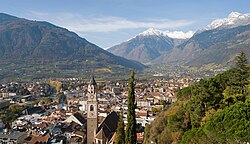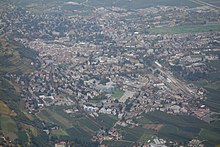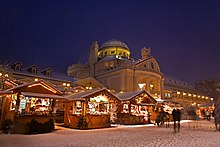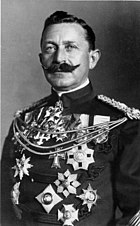Merano
Meran/Merano
Maran(Ladin) | |
|---|---|
| Comune di Merano Stadtgemeinde Meran | |
 | |
| Coordinates:46°40′N11°10′E/ 46.667°N 11.167°E | |
| Country | Italy |
| Region | Trentino-Alto Adige/Südtirol |
| Province | South Tyrol(BZ) |
| Frazioni | Centro (Altstadt), Maia Alta (Obermais), Maia Bassa (Untermais), Quarazze (Gratsch), Sinigo (Sinich), Labers |
| Government | |
| • Mayor | Dario Dal Medico |
| Area | |
| • Total | 26.34 km2(10.17 sq mi) |
| Elevation | 325 m (1,066 ft) |
| Population (30-06-2018)[2] | |
| • Total | 41,051 |
| • Density | 1,600/km2(4,000/sq mi) |
| Demonym | Meranese/Meraner |
| Time zone | UTC+1(CET) |
| • Summer (DST) | UTC+2(CEST) |
| Postal code | 39012 |
| Dialing code | 0473 |
| Patron saint | St Nicholas |
| Saint day | December 6 |
| Website | Official website |
Merano(UK:⫽məˈrɑːnoʊ⫽,[3]US:⫽meɪˈ-⫽,[4]Italian:[meˈraːno]) orMeran(German:[meˈʁaːn]) is acomune(municipality) inSouth Tyrol,Northern Italy.Generally best known for itssparesorts, it is located within abasin,surrounded by mountains standing up to 3,335 metres (10,942 feet)above sea level,at the entrance to thePasseier Valleyand theVinschgau.
The city has been a popular place of residence for several scientists, literary people, and artists, includingFranz Kafka,Ezra Pound,Paul Lazarsfeld,and alsoEmpress Elisabeth of Austria,who appreciated its mildclimate.
Name[edit]
Both the Italian (Merano) and the German (Meran) names for the city are used in English. TheLadinform of the name isMaran.The official name of the municipality (comune) isComune di Meranoin Italian andStadtgemeinde Meranin German (both are in official use).
History[edit]
Archaic names of the city areMairania(from 857 AD) andan der Meran(from the 15th century).[5]In 17th-centuryLatin,the city was calledMeranum.[6]
Origin[edit]

The area has been inhabited since the third millennium BC, as shown by the presence ofmenhirsand other findings. The story of the city proper began in 15 BC when theRomansoccupied theAdigevalley founding a road station,Statio Maiensis.
The settlement was first mentioned in an 857 deed asMairania.The Counts atCastle Tyrolelevated Merano to the status of acityduring the 13th century and made it the capital of theirCounty of Tyrol.After the county had been handed over to theHabsburg dynastyin 1363 upon the abdication ofMargaret, Countess of Tyrol,in 1420 DukeFriedrich IVofAustriamoved the Tyrolean court toInnsbruck.Though Merano remained the official capital until 1848, it subsequently lost its predominant position and almost all its importance as an economic hub across the roads connecting Italy and Germany. The important mint was also moved toHall in Tirolin 1477.[7]
Modern history[edit]
TheTyrolean Rebellion of 1809against theFrenchoccupation drew attention again to Merano. In that year, on the Küchelberg above the city, a peasants' army eked out a victory against the united French andBavarianforces before their revolt was finally crushed. AfterWorld War I,under theTreaty of Saint-Germain-en-Laye,Merano became part of theKingdom of Italywith the rest of the southern part of the formerCisleithaniancrown land of Tyrol.
During theNazioccupation of the region in 1943–5, the Meranese Jewish population was almost completelydeported and murderedwithin concentration camps.[8]
Coat of arms[edit]

The city'scoat of armsdepicts the red Tyrolean eagle sitting on a wall with four pieces of Ghibelline battlements and three arches that symbolize the city. The arms is known from the 14th century and the oldest seal dates from 1353, while the coloured one since 1390. In a 1759 image, the eagle is represented with a crown and a green wreath of honour. After World War I and the annexation of the city from Austria-Hungary to Italy, it was given a new coat of arms in 1928, which looked similar to the old one, but with five parts of the battlements and the arches with the gates opened on a lawn of shamrock. A mural crown was placed above the shield.[9]The five parts of the battlement represented the districts of Maia Bassa, Merano (old city), Maia Alta, Quarazze andAvelengo,which were incorporated into the city by the Italian fascists.[10]After World War II, Avelengo became independent again and the historical coat of arms was restored.[11][12]
Main sights[edit]

Among the city's landmarks are the medievalcity gatessuch as theVinschgauer Tor,Passeirer Tor,and theBozener Tor.Also belonging to the fortifications is the medieval Ortenstein tower, popularly calledPulverturm(lit. "powder tower" ).
The main churches are the GothicSt. Nicholas' Churchand theSt. Barbara's Chapel,both dating to the 15th century. Also dating to this period is the Princely Castle (Landesfürstliche Burg), which was a residence of ArchdukeSigismundofAustria.
TheSteinerner Stegstone bridge crosses thePasser riverand dates to the 17th century.
The city saw further development as it became increasingly popular as a spa resort, especially afterEmpress Elisabeth of Austriastarted visiting. Dating from the 19th century are theCivic Theatre,theKurhausand theEmpress Elisabeth Park.Also famous are the archedWandelhallepromenades along the river.
After the annexation of the city by Italy in 1919, theFascistauthorities constructed the newcity hallin the 1920s.
Outside the city isTrauttmansdorff Castleand itsgardens.Located there is the Museum of Tourism, which was opened in the spring of 2003 and shows the historical development of tourism in the province.Tirol Castleis also close by.
Climate[edit]

Merano is on the borderline between several climates. Officially, it has anoceanic climate(Cfb). However, it is close to beinghumid subtropical(Cfa) due to the mean temperature in July being just under 22 °C; even on those terms, the overnight lows in the winter bring the mean temperatures low enough for the city as a whole to havecontinental(Dfa/Dfb) influences with more distinct seasons.
The average daily temperatures in summer in Merano lie between 27 and 30 °C, while at night temperatures usually drop to between 12 and 15 °C. The average daily temperatures in winter lie between 6 and 10 °C, while at night temperatures usually drop to between -4 and -2 °C. The wettest month is August with 96 mm, while the driest is February with only 25 mm. This data was measured at the weather station Merano/Gratsch at an altitude of 333 metres between 1983 and 2017.
| Climate data for Merano (1983–2017) | |||||||||||||
|---|---|---|---|---|---|---|---|---|---|---|---|---|---|
| Month | Jan | Feb | Mar | Apr | May | Jun | Jul | Aug | Sep | Oct | Nov | Dec | Year |
| Record high °C (°F) | 21 (70) |
23 (73) |
27 (81) |
31 (88) |
37 (99) |
39 (102) |
40 (104) |
40 (104) |
35 (95) |
29 (84) |
21 (70) |
19 (66) |
40 (104) |
| Mean daily maximum °C (°F) | 6.4 (43.5) |
9.6 (49.3) |
15.1 (59.2) |
18.8 (65.8) |
23.5 (74.3) |
27.2 (81.0) |
29.6 (85.3) |
28.6 (83.5) |
23.7 (74.7) |
17.9 (64.2) |
10.9 (51.6) |
6.5 (43.7) |
18.2 (64.8) |
| Daily mean °C (°F) | 1.3 (34.3) |
3.8 (38.8) |
8.4 (47.1) |
12.0 (53.6) |
16.4 (61.5) |
19.8 (67.6) |
21.9 (71.4) |
21.3 (70.3) |
17.1 (62.8) |
12.1 (53.8) |
5.7 (42.3) |
1.7 (35.1) |
11.8 (53.2) |
| Mean daily minimum °C (°F) | −4.0 (24.8) |
−2.3 (27.9) |
1.6 (34.9) |
5.0 (41.0) |
9.3 (48.7) |
12.4 (54.3) |
14.2 (57.6) |
13.9 (57.0) |
10.2 (50.4) |
6.1 (43.0) |
0.5 (32.9) |
−3.3 (26.1) |
5.3 (41.5) |
| Record low °C (°F) | −19 (−2) |
−13 (9) |
−12 (10) |
−4 (25) |
−2 (28) |
2 (36) |
2 (36) |
1 (34) |
−2 (28) |
−8 (18) |
−10 (14) |
−13 (9) |
−19 (−2) |
| Averageprecipitationmm (inches) | 26.4 (1.04) |
24.5 (0.96) |
36.9 (1.45) |
61.7 (2.43) |
80.0 (3.15) |
94.7 (3.73) |
83.8 (3.30) |
96.3 (3.79) |
72.3 (2.85) |
74.9 (2.95) |
84.5 (3.33) |
37.9 (1.49) |
773.8 (30.46) |
| Source: Landeswetterdienst Südtirol[13][14] | |||||||||||||
Culture[edit]
Food[edit]
The area is well known for its wines, both white and red, and vineyards extend right into the city. The local wine,Meraner Leiten (Meranese di collina),is a lightred wine,best drunk young.[15]There are also extensive orchards, and apples are exported throughout Europe. TheForst Breweryon the edge of the city produces a popular range of beers, sold throughout Italy and Europe.
Cultural events[edit]

Merano organizes the following events every year.
- Asfaltart
- Festival MeranOJazz
- Meraner Musikwochen
- Christmas market Merano
- Merano WineFestival
People[edit]




Early times[edit]
- Arbeo of Freising(died 784), early medieval author and bishop
- Johann Baptista Ruffini(1672–1749), salt trader
19th century[edit]
- Pius Zingerle(1801–1881), an Austrian Orientalist
- Ludwig Freiherr von und zu der Tann-Rathsamhausen(1815–1881 in Meran), a Bavarian general[16]
- Oskar Freiherr von Redwitz(1823–1891), a German poet, lived in Merano from 1872[17]
- Ignaz Vincenz Zingerle(1825–1892), poet and scholar[18]
- Peretz Smolenskin(1842–1885 in Meran), a Russian-born Zionist and Hebrew writer[19]
- Hermann von Tappeiner(1847–1927), physician and pharmacologist, usedphotodynamic therapy
- SirRudolf Carl von Slatin(1857–1932), soldier and Inspector General of Sudan[20]
- Ferdinand Behrens (1862-1925), painter and city portraitist[21]
- Leo Putz(1869–1940), Tyrolean painter
- Prince Emmanuel, Duke of Vendome(1872–1931), a French royal from theHouse of Orléans
- Prince Francis Joseph of Braganza(1879–1919), officer in theAustro-Hungarian Armyand victim of sex scandals and swindles
- Richard Steidle(1881–1940 in Buchenwald), lawyer, leader of the paramilitaryHeimwehrin Tyrol
- Erna Ellmenreich(1885–1976), operatic soprano, a member of theStaatstheater Stuttgart
- Oswald Menghin(1888–1973), university professor, prehistorians, minister of education
- Heinz von Perckhammer(1895–1965), photographer, known for his Chinese nudes
- Ludwig Bemelmans(1898–1962), American writer and illustrator of children's books
20th century[edit]
- Hans Andersag(1902–1955), scientist, discoveredChloroquine,a malaria drug
- Anton Malloth(1912–2002), supervisor atTheresienstadt concentration camp
- Silvius Magnago(1914–2010), politician, South Tyrolean governor, father of the autonomy of South Tyrol
- Annelies Reinhold(1917–2007), film actress[22]
- Bargil Pixner(1921–2002), a Benedictine monk, Biblical scholar and archaeologist
- Norbert Untersteiner(1926–2012), pioneer of modern polar science research
- Alberto Lizzio(1926–1999), fictitious conductor of inexpensive, mass market, classical recordings[23]
- Irène Galter(1931–2018), actress[24]
- Maria Bertolini(1931–2022), politician
- Arnaldo Di Benedetto (born 1940), literary critic and professor[25]
- Franco D'Andrea(born 1941), jazz pianist
- Lino Capolicchio(1943–2022), actor, screenwriter and film director[26]
- Cuno Tarfusser(born 1954), judge at the International Criminal Court[27]
- Gloria Guida(born 1955), Italian-speaking actress[28]
- Rudolf Stingel(born 1956), artist
- Ferdinand Gamper(1957–1996), serial killer
- Luca Dipierro(born 1973), animator and writer
Sport[edit]
- Norberto Oberburger(born 1960), retired heavyweight weightlifter, gold medallist at the1984 Summer Olympics
- Edith Gufler(born 1962), former sport shooter, silver medallist at the1984 Summer Olympics
- Günther Steiner(born 1965), motorsports engineer and former team principal ofHaas F1 Team
- Armin Zöggeler(born 1974), luge champion with six Olympic medals and nine world championship golds
- Dominik Paris(born 1989), alpine skier, gold and silver medallist in World Championships
- Daniel Frank(born 1994), ice hockey player
- Daniel Grassl(born 2002), figure skater at the2022 Winter Olympics,silver medalist at the2022 European Figure Skating Championships
Economy[edit]

Merano is a popular tourist destination especially forGermansand Italians. In the summer, there are concerts on the promenade almost daily, and there are fine walks around the city and in the surrounding hills, not least "Meran/o 2000", where there is also skiing in winter. The city is reachable with the railwayBolzano-Merano, which continues to the Vinschgau Railway Merano-Malles.
Society[edit]
According to the 2011 census, 50.47% of the resident population spoke German as mother language, 49.06% Italian, and 0.47%Ladin.[29]
Sport[edit]
Achess opening,theMeran Variationof theSemi-Slav Defense,is named after the city, from its successful use byAkiba RubinsteinagainstErnst Grünfeldduring a tournament held in the city in 1924.[30]In 1981, theWorld Chess Championshipmatch betweenAnatoly KarpovandViktor Korchnoiwas held in Merano. The first act of the musicalChessalso has a world chess championship match set in Merano, and features a song entitled "Merano", which includes the line, "rosy-cheeked Merano, flourishing to a fault".
The city'shandballteam,Pallamano Merano,is one of the most successful in Italy, winning thescudettoin 2005. Theice hockey teamwon two national championships but currently plays in the second division,Serie B.
Each September, theGran Premio Meranotakes place in theMaia Racecourse;this is the most famous ItalianSteeplechase.
Merano hosted the1953,1971and1983 ICF Canoe Slalom World Championships.This is where the well known 'Merano' move was created due to a tricky upstream gate. This move is now used and well known by manyslalompaddlers worldwide.
Twin towns and sister cities[edit]
Thetwin towns and sister citiesare:
 Salzburg,Austria
Salzburg,Austria
References[edit]
- ^"Superficie di Comuni Province e Regioni italiane al 9 ottobre 2011".Italian National Institute of Statistics.Retrieved16 March2019.
- ^"Popolazione Residente al 1° Gennaio 2018".Italian National Institute of Statistics.Retrieved16 March2019.
- ^"Merano".Collins English Dictionary.HarperCollins.Retrieved28 May2019.
- ^"Merano".Merriam-Webster.com Dictionary.Retrieved28 May2019.
- ^Egon Kühebacher,Die Ortsnamen Südtirols,Vol. 1 (2000), lemmaMeran
- ^Johann Jacob Hofmann,Lexicon Universale(1698), lemma'Tirolis'
- ^https://www.muenze-hall.at/en/COINING/MUeNZ-AUFTRAGSPRAeGUNG
- ^Sabine Mayr (2017), "The Annihilation of the Jewish Community of Meran", in Georg Grote, Hannes Obermair (ed.),A Land on the Threshold. South Tyrolean Transformations, 1915–2015,Oxford, Bern, New York: Peter Lang, pp. 53–75,ISBN978-3-0343-2240-9
- ^Ralf Hartemink (1996)."Meran – Merano".Heraldry of the World.Retrieved17 June2011.
- ^Gryffindor (2011)."Image of the coat of arms during the Italian fascist period".Wikimedia Commons.Retrieved17 June2011.
- ^Prünster, Hans (1972).Die Wappen der Gemeinden Südtirols[The coat of arms of the municipalities of South Tyrol]. Etschlandbücher (in German). Vol. 7. Bozen: Landesverband für Heimatpflege in Südtirol.
- ^Gall, Franz (1960).Österreichischer Wappenkalender(in German).
- ^"23200MS-TS-MeranoQuarazze-MeranGratsch.xls".Monatswerte Temperaturen.Landeswetterdienst Südtirol.Retrieved8 August2018.
- ^"23200MS-PS-MeranoQuarazze-MeranGratsch.xls".Monatswerte Niederschläge.Landeswetterdienst Südtirol.Retrieved8 August2018.
- ^Hugh Johnson's Pocket Wine Book 2006
- ^.Encyclopædia Britannica.Vol. 26 (11th ed.). 1911. p. 400.
- ^.Encyclopædia Britannica.Vol. 22 (11th ed.). 1911. p. 972.
- ^.Encyclopædia Britannica.Vol. 28 (11th ed.). 1911. p. 985.
- ^Abrahams, Israel(1911)..Encyclopædia Britannica.Vol. 25 (11th ed.). p. 278.
- ^.Encyclopædia Britannica(12th ed.). 1922.
- ^German Wiki, Ferdinand Behrens
- ^IMDb Databaseretrieved 22 June 2019
- ^IMDb Databaseretrieved 22 June 2019
- ^IMDb Databaseretrieved 22 June 2019
- ^Italian Wiki, Arnaldo Di Benedetto
- ^IMDb Databaseretrieved 22 June 2019
- ^Biography of Judge Cuno Jakob TARFUSSERArchivedJune 27, 2009, at theWayback Machine
- ^IMDb Databaseretrieved 22 June 2019
- ^"Volkszählung 2011/Censimento della popolazione 2011".Astat Info(38). Provincial Statistics Institute of the Autonomous Province of South Tyrol: 6–7. June 2012.Retrieved2012-06-14.
- ^"An Opening Created in 1924 Still Leads to Complex Battles",New York Times,29 January 2006
Further reading[edit]
- Norddeutscher Lloyd (1896),"Meran",Guide through Germany, Austria-Hungary, Italy, Switzerland, France, Belgium, Holland and England,Berlin: J. Reichmann & Cantor,OCLC8395555,OL24839718M
- Coolidge, William Augustus Brevoort(1911)..InChisholm, Hugh(ed.).Encyclopædia Britannica.Vol. 18 (11th ed.). Cambridge University Press. p. 148.
- Sabine Mayr (2017), "The Annihilation of the Jewish Community of Meran", in Georg Grote, Hannes Obermair (ed.),A Land on the Threshold. South Tyrolean Transformations, 1915–2015,Oxford, Bern, New York:Peter Lang,pp. 53–75,ISBN978-3-0343-2240-9
- Patrick Rina, Veronika Rieder (eds) (2020).Kafka in Meran. Kunst und Politik um 1920.Bozen-Bolzano: Edition Raetia,ISBN978-88-7283-743-6.
External links[edit]
 Meranotravel guide from Wikivoyage
Meranotravel guide from Wikivoyage- Official website
- Meran.eu,Homepage of the Tourism Authority





